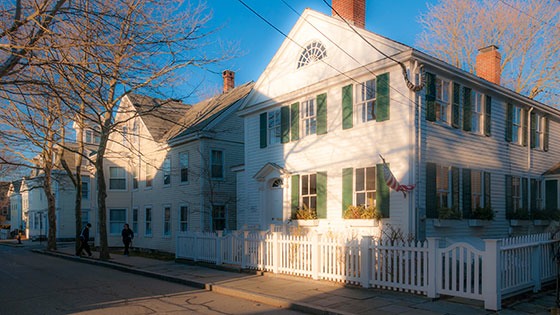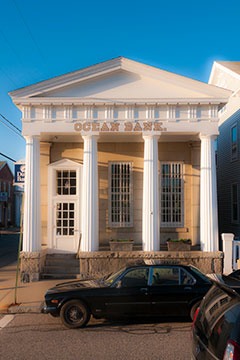search the Original Green Blog

The impatience of the development industry and its municipal regulators clearly contributed to the Meltdown, and a case could be made that impatience was actually the prime culprit. Developing impatiently means building large swaths of similar product efficiently and quickly. The public and private sectors each need to learn some lessons from the ways most great old places developed because those ways are far more sustainable and require a lot less debt, as we discussed recently. Here are the forces at work today that prevent us from building patient and sustainable places today:
Market Surveys

delightful… but there are no "sweet spot
houses" in this picture
Bankers usually require developers to provide market surveys showing that there is a need for the developments they're proposing. Typical market survey firms do what seems like the logical thing and look both at what has sold in the past and also at economic forecasts for the market in question. But there are two serious flaws in the system: First, this "rear view mirror approach" will almost always predict some combination of the previous best-sellers. It is incapable of predicting what people would prefer if they were given a choice. So they usually call for small variations on the "sweet spot house." The second problem is that if a survey calls for 500 new houses in the market, 5 developers might take that same survey to 5 different banks and get approved to build 5 x 500 = 2,500 houses. So market surveys can be wildly deceptive, and they are a major force for homogenizing new housing offerings.
Appraisals

Does this look like a $25/square foot home? Even in 1984?
Appraisers base their work on "comps," which is short for "comparable sales" of properties in the same market in the recent past. If you're building a house type that hasn't been built in recent years (or ever) in your market, appraisers don't have any recent sales to compare it to, so they kick into their "dark side mode" of ultra-conservative appraising. When Wanda and I built our house in the 1980s that didn't need a conventional heating and cooling system because it conditioned itself passively, the appraiser assigned it a ridiculously low value of $25 per square foot, forcing us to finance a large part of the house on credit card debt, which financially burdened us almost to the breaking point for several years thereafter. Most people would have done the sane thing and abandoned their dream of building a sustainable homestead. The appraisal system, then, has a similar effect to market surveys: forcing the development industry to build what it has built before by severely discouraging anything new. And of course, building many of the same types of houses plays right into the industrial homebuilders' impatience because it allows them to carpet the land with subdivisions quickly.
Development Lending

Because we distrust new development, our city planning departments require developers to show exactly what the final development will look like. They are then required to build everything out to its climax condition from the beginning, burdening developments with millions in infrastructure costs before any real estate is sold. Many developments, including several well-designed ones I'm aware of (and more that I certainly don't know about,) have failed in recent years because of this huge front-end burden coming during the Great Recession. So it should come as no surprise that once that "interest clock" starts ticking on their loans down at the bank, developers have little choice but to be impatient in everything that they do to develop their property. There's no ill intention here; they simply have no choice.
Home Mortgages

President Jefferson wasn't above starting in a little cottage…
why are we?
Bankers play a role at both the scale of the neighborhood and the scale of the home. If we built houses in small increments that we could afford to pay for at the time, then we wouldn't need home mortgage bankers very often. Thomas Jefferson, for example, built and lived in one of the two small cottages behind Monticello while he built the rest of the house over nearly a decade. But because our whole system is impatient, we are forced to build the complete house from the beginning. And so we're forced to make our biggest lifetime purchase: the home mortgage.
Insurance

hurricane-resistant architecture has strong
masonry first level that can simply be hosed
out after a storm
Because those mortgages on the big house we might never fully need are so large, the bankers have no choice but to force us to insure our homes against all sorts of threats. And because we're insured, we don't have the incentive to build durable buildings that would survive most of those threats. Durability is a special kind of patience, because it extends a building's life long into the future.
Mortgage Bundling
Once, you merely had to persuade your local banker to loan you the money to build your home, but no more. Now, mortgages are bundled and sold to investors, so the bankers are limited not only by their own judgement, but also by the investors' guidelines. Mortgage bundling is the biggest iron fist in the homogenization of housing into just a few house types. Bundling is also one factor broadly blamed for creating the Meltdown for several reasons that have been written about by many experts… just Google it if you're interested.
Real Estate
Real estate agents foster housing homogenization in a very direct way: Talk to most agents about buying a house and they'll steer you to houses with a whirlpool tub, for example. They'll tell you that you need it "for resale." In other words, even if you never get in a whirlpool tub, you need to buy a house with one anyway because someone else might want one. Never mind the fact that if you polled the public, only a tiny percentage use a whirlpool tub on a regular basis.
Combine all these factors, and it's crystal clear why we've built the way we've built in recent decades. But as we look at how the system is now so broken, it's also clear that American development needs a strong does of patience… don't you think?
~Steve Mouzon
PS: Here's how we got in this mess to begin with, and the story of a little town that bucked the trend with famous results.


